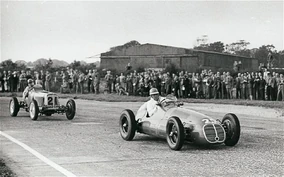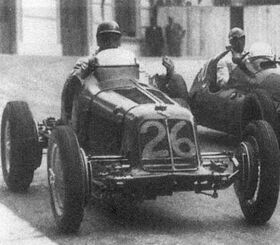Frederick Robert "Bob" Gerard (born 19 January 1914 in Leicester, Leicestershire, England, United Kingdom – died 26 January 1990 in South Croxton, Leicestershire, England, United Kingdom) was a British racing driver who competed in Formula One from it's inception in 1950 to 1957. Notable for wearing spectacles for his nearsightedness on the racetrack, he managed to secure three sixth-place finishes in aging machinery.
Born into an automotive family, Gerard started racing in his father's Riley, taking part in hillclimbs in the 1930s. He later started club races before the war interrupted his career. After the war, he purchased an ERA from Reg Parnell and after buying another ERA, stated competing in Grand Prix races.
He was successful; he won races in the British Empire Trophy (three times), the Jersey Road Race (twice) and the Ulster Trophy; while during the British Grands Prix he managed two podiums in 1948 and 1949.
Gerard competed at the first World Championship race, the 1950 British Grand Prix, but finished in sixth place, just outside of the points. He then proceeded to finish the next race, the Monaco Grand Prix, in sixth place as well.
Switching to a Cooper chassis in 1953, Gerard managed to keep up the impressive performances in home races, winning the Curtis Trophy and Joe Fry Memorial Trophy in 1953 and the Daily Record Trophy. He would score another sixth place at the 1957 British Grand Prix, his final Championship Grand Prix, before finishing his Grand Prix career in 1958. He continued racing into the 1960s, and acted as an entrant for up-and-coming drivers until the 1980s.
Formula One Career
Before Formula One
Gerard cut his teeth competing in hillclimbs in the 1930's in the family Riley and was a regular at local club meetings at his local Donington Park achieving strong results ere and at Brooklands.
After the war, Gerard purchased his first out and out racing car, an ERA R4A, purchased off Reg Parnell for £1000

Gerard in his aging ERA in pursuit
and used his engineering nous to tune the car and other ERA's followed as he and his wife Joan contested hillclimbs and circuit races whilst he continued to modify the cars.
Gerard used his modified ERA 14B to win three back to back British Empire Trophies in 1947, 1948 and 1949 and used this decade old car to finish third at the 1948 British Grand Prix behind the two brand new Maserati's of Alberto Ascari and Luigi Villoresi and a year later in the 1949 British Grand Prix finished second to Toulo de Graffenried.
1950

A battling 6th for Gerard at Monaco
Bob Gerard continued his remarkable giant slaying in his ancient ERA into the 1950 Formula 1 season with a sixth place finish, ahead of Maserati and Talbot-Lago machinery at Silverstone.
A fete he achieved again at the second round of the season at Monaco, beating Talbot-Lago driver Johnny Claes into 6th.
Formula One Statistical Overview
Formula One Record
| Year | Entrant | Team | WDC Points | WDC Pos. | Report |
|---|---|---|---|---|---|
| 1950 | Bob Gerard | ERA | 0 | NC | Report |
| 1951 | Bob Gerard | ERA | 0 | NC | Report |
| 1953 | Bob Gerard | Cooper-Bristol | 0 | NC | Report |
| 1954 | Bob Gerard | Cooper-Bristol | 0 | NC | Report |
| 1956 | Bob Gerard | Cooper-Bristol | 0 | NC | Report |
| 1957 | Bob Gerard | Cooper-Bristol | 0 | NC | Report |
Career Statistics
Template:Statbox
Career Results
| Complete Formula One Results | |||||||||||||||||||||||||
|---|---|---|---|---|---|---|---|---|---|---|---|---|---|---|---|---|---|---|---|---|---|---|---|---|---|
| Year | 1 | 2 | 3 | 4 | 5 | 6 | 7 | 8 | 9 | Pts | Pos
Template:1950 Results/9 Template:1951 Results/9 Template:1953 Results/9 Template:1954 Results/9 Template:1956 Results/9 Template:1957 Results/9 | ||||||||||||||
| Key | |||||
|---|---|---|---|---|---|
| Symbol | Meaning | Symbol | Meaning | ||
| 1st | Winner | Ret | Retired | ||
| 2nd | Podium finish | DSQ | Disqualified | ||
| 3rd | DNQ | Did not qualify | |||
| 5th | Points finish | DNPQ | Did not pre-qualify | ||
| 14th | Non-points finish | TD | Test driver | ||
| Italics | Scored point(s) for Fastest Lap | DNS | Did not start | ||
| 18th† | Classified finish (retired with >90% race distance) | NC | Non-classified finish (<90% race distance) | ||
| 4thP | Qualified for pole position | [+] More Symbols | |||
